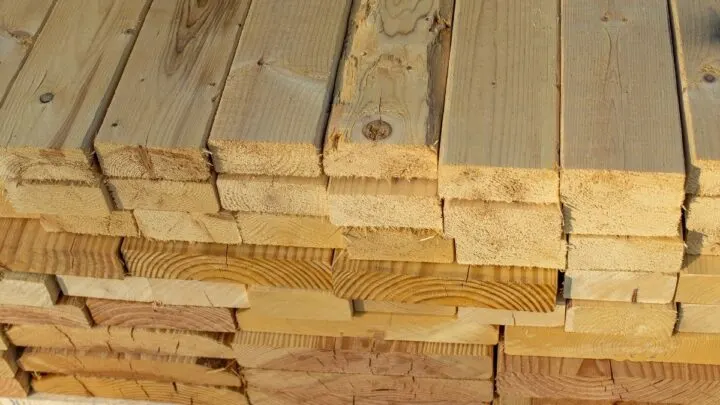When it comes to building and construction, the most common type of lumber that we see used is a 2×4, but how much weight can it hold?
A 2×4 is reliable and highly versatile lumber that can be seen across many different industries and building designs around the globe.
A 2×4 can hold approximately 1,000 lbs when it’s in a vertical position, given that the weight is not going against the grain. When it’s laying horizontally, it can hold anywhere between 20-40 lbs. This all depends on its length, grade, load, and wood species.
Whether you are working in construction or planning on doing some woodworking, understanding exactly how much a 2×4 can hold before you put its weight capacity to the test is a good idea.
A 2×4 is notoriously tough and incredibly reliable, which is why it is so universally relied on in various industries.
However, if you want are planning on using a 2×4 for a legitimate building project, having an accurate figure for how much weight this piece of lumber can support is going to be crucial.
A failure to get a realistic weight for your 2×4’s hold can result in serious complications for a building project which can not only sabotage the development but also lead to safety concerns.
With that being said, there are many different factors at play when it comes to how much weight a 2×4 can support, and understanding them will allow you to use this piece of lumber with absolute confidence.
To help you understand this further, we are going to take a closer look at exactly how much weight a 2×4 can hold.
How Much Weight Can a 2×4 Hold?
A 2×4 is a very dynamic type of lumber and it has proven to be useful in so many situations for building and construction.
However, it is the dynamic nature of the 2×4 that can make its weight capacity rather challenging to pinpoint. We use 2x4s in various ways, which puts the lumber to the test at different angles and weight loads.
What we have found is that a 2×4 does not have a universal amount of weight that it can support, as it can handle more or less depending on how it ends up getting used.
Understanding physics certainly helps us pinpoint exactly how much weight a 2×4 can handle based on the angle at which it’s positioned.
When you take a look at a construction site, you will see 2x4s positioned at distinct angles to get different levels of support.
Most commonly, we see 2x4s angled either vertically, horizontally, or on their edge.
Each of these angles has a very different weight load capacity, which is why we need to take a closer look at each one to understand how much the lumber can ultimately hold.

Vertical 2×4 Weight Capacity
If you want to get the most amount of support out of a 2×4 as possible, using it in a vertical position is going to be the safest angle to maximize its weight capacity.
In this position, you can expect to get as much as 1,000 lbs out of just a single 2×4.
However, it is quite rare for construction projects to rely on a single 2×4 for support.
Most projects require multiple 2x4s to be used in a vertical position to add extra support, which can greatly increase the weight capacity to be 20,000 lbs (or even more).
The reason that a vertical 2×4 can handle such an impressive weight load is that the distribution is evenly spread across the entire piece of lumber.
In addition, we need to keep in mind that 2×4 is not as strong when it is being strained along its grain.
When kept in a vertical position, a 2×4 is supporting weight against its grain which adds a considerable amount to its hold capacity.
Horizontal 2×4 Weight Capacity
The weight that a 2×4 can hold when it is horizontal can be particularly tricky to identify – given that the overall length of the lumber greatly influences how much it can support.
In addition, we need to keep in mind that a 2×4 can handle weight differently based on what part of the wood the weight is centered.
If the weight is evenly spread across the entire 2×4 when in a horizontal position, this figure is easier to evaluate.
However, if the weight is concentrated on a specific part of the lumber then its capacity can fluctuate quite a lot.
That is why 2x4s that are placed horizontally are generally quoted with a weight capacity figure that is set at the lowest breaking point to ensure that it is reliable.
With that being said, you can expect a 2×4 to hold anywhere from 20 to 40 lbs when it is positioned horizontally.
This is how much the lumber can hold per linear foot and it is also assuming that the weight is being spread across the entire 2×4.
Edge 2×4 Weight Capacity
A 2×4 can also be used very effectively when it is positioned on its edge.
The weight that the lumber can handle is significantly increased in this position compared to a horizontal angle, given that the 2×4 has the thick side of the wood for support.
This opens up a considerable amount of additional weight that the lumber can hold – with most handling up to 300 lbs in this position.
Much like with the horizontal weight load capacity, we need to keep in mind that this figure can also fluctuate depending on how the weight is distributed on the wood – with even weight supporting considerably more than a concentrated load.

Factors that Influence a 2×4’s Weight Capacity
In addition to angle and position, we also need to carefully assess the specs and conditions of the lumber to determine its weight load capacity.
Not all 2x4s are made equal.
Some are made to a higher quality standard than others, which results in the amount of weight that they can support increasing.
Understanding all of the factors that influence a 2×4’s durability and specs is how we can pinpoint an accurate figure for its weight support threshold.
Grade
When lumber is cut into a 2×4 shape, it is graded by the distributor based on its quality – with higher grades being able to support greater weight.
A sign of quality is a 2×4 that has fewer anomalies and is in pristine condition.
After the lumber is cut, it is evaluated for any anomalies so that it can be appropriately sorted. During this process, 2x4s that have any defects such as warping, knots, and other defects are put into a lower grade category.
However, a quality 2×4 will have virtually no anomalies and will be put into the highest grade category – implying that it will have a higher weight load capacity.
Each grade that a 2×4 falls into will be categorized for a specific type of use. For industries and safety features, high-grade 2x4s are relied on to adhere to safety standards.
Lower-grade 2x4s are not nearly as durable and should not be used in any way that can lead to safety risks. These are the common grades that we see for 2x4s and how they are used:
- No.1 & 2 – Construction
- N.3 – Stud Grade
- No.4 – Light Framing
Without a trained eye to assess the 2×4, it can be difficult to gauge what grade the lumber is.
To make this process easy and efficient, lumber distributors generally stamp the 2×4 with a grade classification so that it can be used appropriately and easily identified.
Wood Species
A critical factor that influences how much weight a 2×4 can handle is the wood species that it originated from – with some species being considerably stronger and more durable than others, enabling them to hold more weight.
The key characteristic that determines a quality piece of lumber is its density.
How dense a 2×4 is will greatly influence its weight capacity, which is why development and woodworking projects that will be heavily strained rely on 2x4s that were made from high-quality wood species.
One of the most common types of wood species that we see used for 2x4s is a Douglas Fir.
This is a go-to amongst industry professionals and it is incredibly reliable and durable.
However, there are wood species for 2x4s that are better than this, which also have a higher weight capacity such as:
- Spruce Pine Fir
- Southern Yellow Pine
These wood species are the most ideal options, which is why industries that require 2x4s with a maximum weight load choose them over other types of lumber on the market.
More often than not, wood species that can support more weight are priced higher than generic options.
Span & Spacing
Another vital component for determining how much a 2×4 can hold is the span of the joists and the spacing between each piece of lumber.
When 2x4s are arranged in a support system such as for flooring or roofing, the amount of spacing between the pieces of lumber can greatly affect how much the weight capacity will be.
The closer the 2x4s are together, the more weight they can hold.
In addition, the span of the 2×4 is equally as important.
If a 2×4 has been stretched out over a long distance, the amount of weight that it can support will be decreased.
Whereas if the 2×4 has a shorter span, it will have an increased amount of weight that it can hold.
Load Type
When dealing with weight calculations for 2x4s, we need to not only assess the amount of weight that is being put onto the lumber but also the type of weight.
When evaluating the position of a 2×4, we discussed how weight distribution can play a critical role in how much weight the lumber can handle.
Industry professionals categorize this as “load type.”
To get an accurate figure for how much weight a 2×4 can hold we need to also keep in mind that each piece of lumber is going to handle one load type differently than another.
We can calculate how the load affects the 2×4 by multiplying the pounds of pressure per square foot of lumber.
Let’s break down each load type to understand how it affects a 2×4’s weight capacity.
Live Load
A live load has to do with weight that changes on the surface of the 2×4.
More often than not, this is caused by human movement, light machinery, or environmental factors such as rain and snow.
Dead Load
A dead load is essentially any type of weight that is added to the 2×4 that will not move.
This is defined generally by permanent structures and features that are commonly found inside buildings and homes such as walls, roofs, and rafters.

Wood Moisture
When selecting a 2×4 with an optimum weight capacity, it’s important to assess its moisture content, as this can influence how much the lumber can hold.
You want to choose a 2×4 that is dry to get the most amount of weight possible, as moist lumber will not offer as much support.
Whenever you see lumber that is marked as “green,” it implies that it has anywhere from 24 to 29% moisture inside of it.
This is not going to be ideal for maximizing the amount of weight that a 2×4 can hold.
The way that you get rid of this moisture is by heating it up inside of a kiln.
You can order 2x4s that have specifically been dried in this way to get the most out of their weight capacity.
Although this process does not remove all of the moisture from the wood it does take out the majority of it, which adds a considerable amount of weight to the overall amount that the 2×4 can hold.
If you see lumber that has been marked as ‘dry’ it was either kiln-dried or air-dried.
Regardless of how it was processed, this generally adds as much as double the amount of weight that a 2×4 can hold to its overall capacity – making it an ideal choice for industrial and construction use.
Summing Up How Much Weight a 2×4 Can Hold
If you’re looking to start building with 2x4s, knowing how much weight they can hold is crucial. Most 2x4s can hold anywhere from 40-1,000lbs, depending on what position it’s in and how wet the material is.
Make sure you consult a professional if you’re going to build anything involved, and always look into how much weight your materials can hold!


